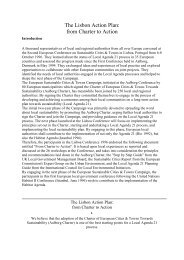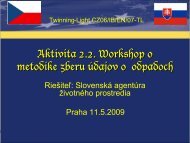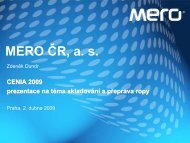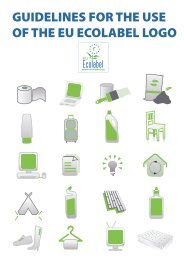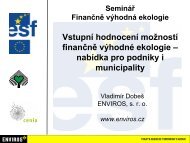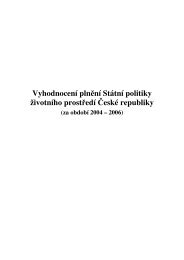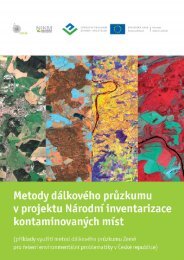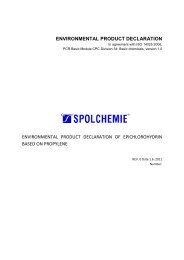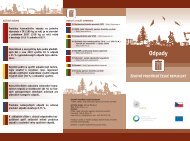Environmental Technologies and Eco-innovation in the Czech ...
Environmental Technologies and Eco-innovation in the Czech ...
Environmental Technologies and Eco-innovation in the Czech ...
Create successful ePaper yourself
Turn your PDF publications into a flip-book with our unique Google optimized e-Paper software.
esources equipped with CCS are identified as low-emission or even zero-emission<br />
energy sources. The purpose of CO 2 underground storage is to restrict greenhouse<br />
gas emissions <strong>in</strong>to <strong>the</strong> atmosphere <strong>and</strong> <strong>the</strong> possibility of eventual CO 2 use <strong>in</strong> <strong>the</strong><br />
future. However, CCS technologies have not yet been developed <strong>and</strong> verified on a scale<br />
necessary for mass use <strong>in</strong> energy. Support for <strong>the</strong> establishment of 10 to 12 full capacity<br />
CCS demonstration units <strong>in</strong> <strong>the</strong> EU, which should be put <strong>in</strong>to operation by 2015, is one<br />
of purposes of <strong>the</strong> Action Plan for Energy of <strong>the</strong> European Council of March 2007.<br />
The whole energy cycle with CCS technology consists of separat<strong>in</strong>g CO 2 from<br />
combustion products <strong>and</strong> gas be<strong>in</strong>g formed by <strong>the</strong> gasification of carbon fuel, <strong>the</strong>n<br />
transport<strong>in</strong>g separated CO 2 to a stor<strong>in</strong>g facility <strong>and</strong> f<strong>in</strong>ally tak<strong>in</strong>g <strong>the</strong> stored CO 2 to<br />
a suitable deep geologic formation. The European Commission assumes <strong>the</strong> expansion<br />
of <strong>the</strong>se technologies after 2020. Power plants be<strong>in</strong>g built before this date will have to<br />
contemplate <strong>the</strong> later addition of this system.<br />
Presently, ČEZ, a.s. is plann<strong>in</strong>g to build facilities for CO 2 storage <strong>in</strong> two locations <strong>in</strong><br />
<strong>the</strong> <strong>Czech</strong> Republic. The first one is supposed to be <strong>in</strong> Ledvice, where <strong>the</strong> construction<br />
of a new unit is planned. The o<strong>the</strong>r is supposed to be <strong>in</strong> <strong>the</strong> Hodonín region. The costs<br />
of us<strong>in</strong>g this technology range from 25 to 60 EUR per tonne of CO 2 . For <strong>in</strong>dustrial use,<br />
a price around 20 EUR per tonne of CO 2 would be acceptable.<br />
2.6 | Nuclear energetics<br />
One of <strong>the</strong> options to reduce <strong>the</strong> negative impacts of emissions on <strong>the</strong> Earth’s climate<br />
is to use nuclear energy. Nuclear power eng<strong>in</strong>eer<strong>in</strong>g does not practically produce<br />
any <strong>in</strong>ternationally reported greenhouse gases (CO 2 ) <strong>and</strong> as an alternative to coal<br />
sources it significantly contributes to reduc<strong>in</strong>g emissions. For example, a 1000 MW<br />
nuclear power plant will decrease CO 2 emissions <strong>in</strong>to <strong>the</strong> air by 960 tonnes of CO 2 per<br />
1 GWh of electricity compared to a <strong>the</strong>rmal plant of <strong>the</strong> same capacity. In addition, it<br />
does not use primary sources that can be used for o<strong>the</strong>r purposes, e.g. <strong>in</strong> chemistry<br />
or medic<strong>in</strong>e.<br />
The current state-of-<strong>the</strong> art nuclear power plant projects that have started <strong>in</strong> F<strong>in</strong>l<strong>and</strong><br />
<strong>and</strong> France use generation III+ reactors. After 2025, generation IV reactors that are<br />
subject to <strong>in</strong>tense research now will be added. The <strong>Czech</strong> Republic participates <strong>in</strong> <strong>the</strong><br />
development of generation IV reactors via <strong>the</strong> Nuclear Research Institute Řež which<br />
provides to <strong>the</strong> EU experimental facilities built from <strong>the</strong> EU Structural Funds. Generation<br />
IV reactors allow for uranium 238, which is non-fission under normal circumstances, to<br />
generate a fissionable material that is used <strong>in</strong> current reactors. This <strong>in</strong>creases <strong>the</strong> fuel




